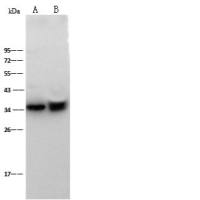Electrophoretic Separation and Immunoblotting of Aβ1–40and Aβ1–42
互联网
1186
The main protein component of the plaques found in the brains of Alzheimer’s disease patients is Aβ, a peptide of 39 to 43 amino acids (reviewed in refs. 1 and 2). Two major Aβ isoforms have been identified in the brains of affected individuals ending at amino acids 40 and 42, respectively (3 ). The longer form, Aβ42, aggregates more rapidly in vitro (4 ) and is preferentially deposited in vivo (3 ,5,6 ). Normally, Aβ is secreted as an apparently soluble molecule (7 -9 ). It is generated by all cultured cells expressing its precursor protein, APP, and can be detected in vivo in the cerebrospinal fluid (10 ) and in plasma (11 ). Mutations linked to familial forms of Alzheimer’s disease have been found in the APP gene as well as two other genes encoding presenilin 1 and presenilin 2. They were shown to alter APP metabolism and, in particular, to either increase total Aβ or the relative abundance of the longer Aβ42 isoform (12 -17 ). These observations have led to the hypothesis that Aβ42 may play a critical role in amyloid plaque formation and the development of Alzheimer’s disease. Obviously methods discriminating between the two major Aβ species are important in order to study this notion.








